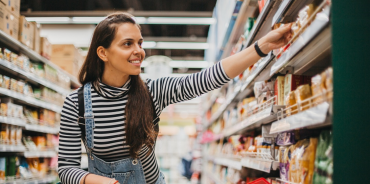Grocery in the Age of Inflation: Learnings and Recommendations – Part I
We’ve seen it on the news, heard it mentioned in every meeting, and even discussed it over dinner with our friends and family. 2022 was a year in which inflation was one of the most talked about themes across the globe, with Google Trends showing a spike in interest that hasn’t been seen since before the tech giant started tracking such things. Inflation’s impact was such that it even influenced our retail predictions for the year ahead.
All signs suggest that our fixation with inflation will remain intact for some time yet, too. Despite the positive impact of higher interest rates (in the United States) and “zero-Covid” policies (China), most of the markets in which we operate (Europe, Asia, South America, the Middle East, and Africa) are still in the midst of this unprecedented age of inflation.
With that in mind, and just over a year since we looked at the “best customer first strategies for inflationary times”, we wanted to share some of our own learnings and recommendations from working with grocery retailers to help them manage their response to this ongoing challenge. In this, the first in a two part series, we’ll look at what we’ve learned over the past year.
When it comes to inflation’s impact on the grocery industry, there are three foundational rules that we need to keep in mind:
- Chasing profitability - When costs rise, consumer packaged goods (CPG) brands and retailers must strive to maintain their profitability. Investors and owners have expectations, and these must be met in both the short and long term.
- Industry conflicts - There is a heightened risk of CPGs and retailers coming into conflict over pricing and margins, requiring new levels of transparency in order to protect shoppers and maintain volume growth.
- Customers questioning habits - With customers facing a cost-of-living crisis, changing behaviours are a given. This is particularly true amongst the least affluent, where food spend represents a higher proportion of their budget and even small fluctuations can make a huge difference.
Let’s look at how those rules have come into play over the past 12 months.
Inflation impacts consumer confidence
Customer confidence has hit a new low in both Europe and North America during the past year, dropping even further than during Covid. In our most recent Customer Pulse study, for instance, more than 50% of global shoppers told us their personal finances are weak, a 10% increase on the year before. One of the main ways in which this low financial confidence has manifested is in the adoption of “value seeking strategies”.
Typically, these involve searching online to find the best deals, greater coupon usage, prioritisation of special offers, a focus on private brand products and more traffic to discounters. We can see this reflected in real world results, too; in the UK, Aldi saw a 26% increase in sales over the Christmas period[1], while penetration of discount retailers in Italy rose from 81.6% in 2020 to 85.9% in 2022[2].
Naturally, this begs one key question: how do CPGs and traditional retailers protect their margins, while simultaneously maintaining a positive and trusting relationship with their customers?
From price indexes to price perception… and then on to value perception
One thing that we’ve seen clearly in recent months is that some retailers have begun to shift their focus from price indexes to price perception. Retailers, especially the top performers, understand that being the cheapest in the market doesn’t always equate with being the most affordable as far as customers are concerned.
Without getting into detail on the consumer psychology behind this (how odd numbers make prices look cheaper than even numbers, the anchoring effect etc.), it’s apparent that retailers have an opportunity to reset their marketing levers and improve their price perception amongst customers, particularly those with the greatest levels of price sensitivity and loyalty.
Some, of course, are going further still. While the top performers may be thinking in terms of price perception rather than price indexes, others have moved on to the issue of value perception – thinking not just about price point or price “image”, but their offer as a whole. Quality, variety, and speed all play a role here, giving retailers access to a wide range of tools with which to create distinctive experiences and win preference over time for those customers they want to win with.
When customers decide where to shop, they do so using a mix of conscious and unconscious parameters. Essentially, they ask themselves “which retailer gives me the best offering, based on my preferences and needs, and the amount I want to spend?”. As a result, their choice of where to shop comes down to a matter of value perception. Critically, that perception also varies by country and customer segment and therefore it’s crucial for retailers being clear on which customer groups they need to focus on and what levers impact their value perception the most to be truly effective.
We’ve seen this time and again in our RPI Series of research studies. In Italy, for instance, promotions are inherently tangled up with pricing, with the resultant issue of “Price Perception” being one of the most influential drivers of where customers choose to shop. In Spain, on the other hand, promotions are not only seen as an issue separate from pricing, they also have little impact on shopper preference.
There are numerous factors at play here, from the structure of the competition through to different ways of thinking and cultural touchpoints. The overall message is clear, however: everything a retailer does has at least some impact on value perception. Store design, layout, assortment, category displays, pricing, communications – it all counts. Recognising this and planning quick wins vs major changes across levers that matter most will ultimately deliver better results in the short and long term.
Predicting a slowdown’s impact on grocery growth
As highlighted by my colleague Feroud in this recent post, many different sources are pointing to a potential economic slowdown for some economies during 2023. Like any other industry, this will have significant implications for grocery, and retail leaders will need to shape their investments around the dual priorities of customer experience and wider efficiencies.
As is the case with value perception, though, circumstances can differ from country to country. When looking at the impact of shifts in GDP on grocery growth, our analysis found that there are key differences across markets. In some countries (Greece, Poland, Switzerland, and the UK), the grocery market more or less follows the same dynamics as GDP. In others (Belgium, Ireland, France), those factors are largely detached.
The other thing to remember is that the actual path for the year ahead isn’t set just yet. A variety of issues are still unfolding, not least the government response to a downturn, which may be very different from what we saw in 2007. Nonetheless, this exercise does at least provide an interesting starting point from which to look at how far and how fast grocery may be impacted by a potential slowdown.
In the next and final piece in this series, we’ll look at some of the priority actions that we believe retailers should take with this backdrop in mind.
[1] Aldi hails record Christmas as World Cup and festive trading boost sales – Retail Week, 3 January 2023
[2] Discount: numeri e fatti per una formula in continua ascesa – GDOWeek, 2 January 2023
Inflation Discovery & Plan
dunnhumby Inflation Discovery & Plan enables retailers to identify the priority actions they can take and the key areas to absorb inflation to deliver to the changing needs of their customers, while creating savings to protect their margin.
Get in touchTOPICS
RELATED PRODUCTS
A look at dunnhumby’s unique Customer Data Science, which is at the core of everything we do.
Data Science solutionsThe latest insights from our experts around the world
Navigating a shifting world: the headline results from our latest Consumer Pulse
Keeping it relevant and authentic: engaging consumers along the purchase journey



